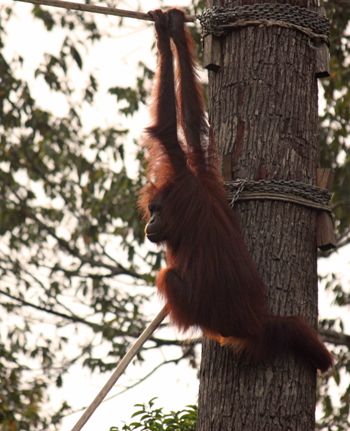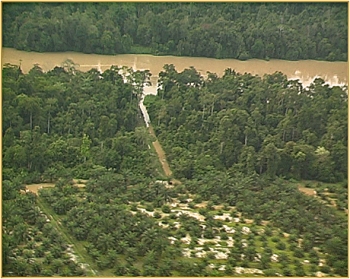Researchers in the Malaysian state of Sabah in Borneo are joyful after receiving confirmation that a young male orangutan used a rope bridge to cross a river, which has separated one orangutan population from another. Due to logging and clearing forests for oil palm plantations, which cover 18 percent of land in Sabah, orangutans on the Kinabantangan River have been cut into fragmented populations.
“Over the years we have received numerous local eye witness reports of the orangutans using these rope bridges but this is the first time we have received photographic evidence which clearly shows a young male orangutan using the first rope bridge we constructed in 2003 to cross over Resang river, a small tributary of Kinabatangan,” explains primatologist, Dr. Isabelle Lackman, Co-Director of the Kinabatangan Orangutan Conservation Project (KOCP) in a press statement.
Photos of a male orangutan using the rope bridge were captured by Ajirun Osman, who says that after the male spent twenty minutes at the rope bridge, he crossed: “it seemed like once he decided to cross, he did so very fast going over in about three minutes from the Pangi Forest Reserve into Lot 1 of the Kinabatangan Wildlife Sanctuary.”
 The young male orang-utan begins his journey across the Resang River, a tributary of the Kinabatangan along a rope bridge constructed in 2003 by the Sabah Wildlife Department and Kinabatangan Orang-utan Conservation Project. Photo by: Ajiran Osman @ Aji. |
Orangutans used to cross such rivers employing the canopies of old growth forests, which easily spanned small rivers. However since the trees have been logged, researchers decided artificial bridges were needed to allow fragmented populations to meet. Six bridges have been built by KOCP, a joint venture between the Sabah Wildlife Department and the French NGO, HUTAN.
“Using rope bridges is a quick fix but eventually the most ideal solution would be to reconnect the forest and we are all working on this. And when I say ‘we’ I mean everyone from Governmental sector to environmental NGOs and crucially the palm oil industry as well,” said wildlife veterinarian Dr. Marc Ancrenaz who is also the Co-Director of KOCP.
A recent survey by the Sabah Wildlife Department and KOCP found 1,000 orangutans in the Lower Kinabatangan river area, inhabiting both protected and non-protected areas. These populations are estimated to go extinct in our lifetime, if they are not re-connected through schemes like the rope bridge, according to genetic studies done by the Sabah Wildlife Department, KOCP, Cardiff University, and the Danau Girang Field Centre.
“Today the orangutan is facing more human made obstacle’s such as illegal planting for oil palm all the way down to the river bank leaving no riparian reserve which are actually required by law under the Environment Protection Enactment of 2002 as well as the Water Resources Enactment of 1998,” says Lackman.
 : An example of an illegal drain built by oil palm plantations to help drain their crop. Such drains create obstacles for orangutans and other wildlife which are unable to cross over to the other side. The orangutan rope bridge built by the Sabah Wildlife Department and the Kinabatangan Orang-utan Conservation Project act as a “quick fix” but ultimately forest corridors are needed to link forest for wildlife survival. |
“Even though it will be an expensive and long process, reconnecting isolated populations which were originally linked together will ensure the long term survival of not only Sabah’s orang-utans but other unique species such as the Bornean pygmy elephants, the sunbears, the clouded leopards and many more,” add Dr. Laurentius Ambu, director of the Sabah Wildlife Department.
Last fall, a conference in Sabah including the Sabah Wildlife Department, NGOs such as HUTAN, and palm oil producers pledged to create wildlife corridors to save the state’s orangutan population and other endangered species. The pledge included land acquisition along rivers, such as the Kinabantangan, and to connect forest fragments.
During the conference, Tan Sri Bernard Dompok, the Minister of the Plantation Industry and Commodities, told member of the press: “I will support the effort to provide a corridor, even to acquire land compulsorily because this is in order to make our agriculture and tourism industry sustainable,”
The Bornean orangutan is currently classified as Endangered by the IUCN Red List, while its southern relation, the Sumatran orangutan, is considered Critically Endangered. Sabah supports an estimated 11,000 Bornean orangutans.
Related articles
Palm oil industry pledges wildlife corridors to save orangutans

(10/03/2009) In an unlikely—and perhaps tenuous—alliance, conservationists and the palm oil industry met this week to draw up plans to save Asia’s last great ape, the orangutan. As if to underscore the colloquium’s importance, delegates on arriving in the Malaysian State of Sabah found the capital covered in a thick and strange fog caused by the burning of rainforests and peat lands in neighboring Kalimantan. After two days of intensive meetings the colloquium adopted a resolution which included the acquisition of land for creating wildlife buffer zones of at least 100 meters along all major rivers, in addition to corridors for connecting forests. Researchers said such corridors were essential if orangutans were to have a future in Sabah.
Orangutans vs palm oil in Malaysia: setting the record straight

(01/16/2010) The Malaysian palm oil industry has been broadly accused of contributing to the dramatic decline in orangutan populations in Sabah, a state in northern Borneo, over the past 30 years. The industry has staunchly denied these charges and responded with marketing campaigns claiming the opposite: that oil palm plantations can support and nourish the great red apes. The issue came to a head last October at the Orangutan Colloquium held in Kota Kinabalu. There, confronted by orangutan biologists, the palm oil industry pledged to support restoring forest corridors along rivers in order to help facilitate movement of orangutans between remaining forest reserves across seas of oil palm plantations. Attending NGOs agreed that they would need to work with industry to find a balance that would allow the ongoing survival of orangutans in the wild. Nevertheless the conference was still marked by much of the same rhetoric that has characterized most of these meetings — chief palm oil industry officials again made dubious claims about the environmental stewardship of the industry. However this time there was at least acknowledgment that palm oil needs to play an active role in conservation.

(03/01/2010) It is no secret that orangutans are threatened with extinction because their rain forests are being destroyed at an alarming rate. Ten years ago, Shawn Thompson, a writer, former journalist and university professor, set out to chronicle the threat to orangutans in a book released in March 2010. The book is called The Intimate Ape: Orangutans and the Secret Life of a Vanishing Species. The book spends most of the time talking about the nature of orangutans and the relationships between orangutans and people. But the ultimate underlying message is there about the source of the peril to orangutans and the solution. Thompson says that the problem of saving orangutans has to do with communications and human nature.














